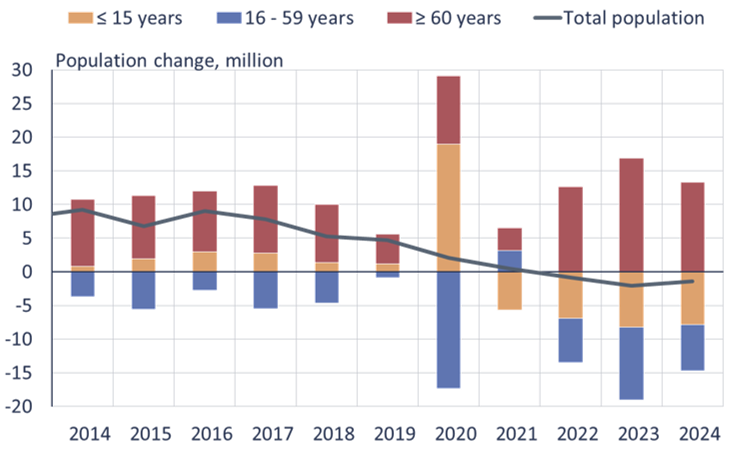BOFIT Weekly Review 08/2025
China’s population continues to decline; birth rate remains low
China’s population at the end of 2024 was 1.4083 billion, or 1.4 million people fewer than in the previous year. 67 % of Chinese (944 million, 11 million more than in 2023) lived in cities. As recently as the late 1990s, the rural-urban population ratio was reversed, with just a third of Chinese living in cities. Not all urban residents have hukou (domicile registration system) status in the cities where they live, however. Only 48 % of the population had an urban hukou in 2023. The number of migrant workers who live and work in a city, but have hukou status in a rural area or another city, reached a record last year of 300 million (21 % of the population).
China’s working-age population (16–59 cohort) has been shrinking since 2012. Last year 858 million Chinese belonged to the working-age cohort (61 % of the population), nearly 7 million fewer than in 2023. 240 million (17 %) were aged 15 or younger and 310 million (22 %) were 60 or older. The number of elderly has grown rapidly. As recently as 2006, there were fewer than 150 million Chinese 60 years or older (11 % of the population). China finally decided last year to begin increasing retirement ages at the start of this year (BOFIT Weekly 38/2024). The very gradual hikes will take place over many years. India surpassed China as the world’s most populous country in 2023. According to UN estimates, the working-age cohort (15–64-year-olds) in India reached 990 million last year, surpassing the same age cohort in China (984 million).
10.9 million people died in China last year and 9.5 million babies were born (0.5 million more that in 2023). Immigration has only the faintest impact on China’s population numbers. Observers say the slight rise in births last year reflects such factors as couples who had put off having a child during the Covid-19 pandemic feeling the time was right. Last year was also the Year of the Dragon according to the Chinese calendar. A child born under the dragon sign of the Chinese zodiac is expected to succeed well in life. For children born in the current year, the Year of the Snake, life’s outlook is not considered as auspicious. China’s birth rate is also expected to decline further this year as the number of marriages dropped to a record low last year. Only 6.1 million couples married in 2024 (7.7 million in 2023). The number of divorces rose to 2.6 million. Most Chinese children are born in wedlock.
Births have decreased as the number of people in their childbearing years declines and the fertility rate decreases. According to the UN’s population forecast, China’s cohort of women of prime childbearing age (20–39 years) last year amounted to 183 million. This size of this cohort peaked in 2002 at 224 million. The UN estimates that China’s fertility rate, i.e. the average number of children an woman gives birth to in her lifetime fell to 1.01 last year. In the UN’s comparison, China’s low rate is approaching that of Singapore (0.95), Taiwan (0.86), South Korea (0.73) and Hong Kong (0.73). Many countries with rapidly aging populations still have higher fertility rates than China, including Japan (1.22), Finland (1.29) and Italy (1.21). The global fertility rate fell to 2.25 in 2024 and is expected to reach 2.07 by 2054, i.e. a level below the stable replacement rate (2.1).
During the years 1979–2015, China pursued a one-child policy that has redefined the culture and attitudes towards having more than one child. The government in recent years has increased measures to encourage couples to have more children, but they have failed to deliver significant results. China’s most recent census was conducted in 2020. Published census figures show that average family size nationally was 2.6 persons and only 37 % of families had children. Two-thirds of children live with both of their parents and a fifth live with one of their parents. 50 million children (17 % of children) lived with neither parent. Among families with children, 60 % had one child, 33 % had two children and 7 % had three or more children. Compared to the previous 2010 census, the share of families with two or more children among families with children increased somewhat, but their share of all families decreased due to the increased numbers of childless families.
China’s population has been shrinking over the past three years.

Sources: NBS, CEIC and BOFIT.